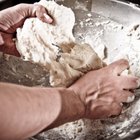Jacob Ammentorp Lund/iStock/GettyImages
Making yeast bread typically involves several basic steps. You need to mix the ingredients, knead the dough, then let it rise before you shape a loaf and bake it. Kneading plays an important role in the formation of a loaf of bread. You knead bread to help gluten, or the combination of water and the proteins, glutenin and gliadin, develop. The gluten in turn forms a mesh structure the traps the gas produced by the yeast, which allows the dough to rise.
How to Knead
You can knead bread dough in a few ways. You can use a machine, such as a stand mixer or a food processor, or you can use your hands. Hand kneading is a little more involved but, can be an enjoyable part of the bread making process. To knead by hand, sprinkle some flour on a clean counter. Set the dough on the counter and sprinkle a bit more flour on top of it. Pick up the edge of the dough that is farthest from you and fold it over the rest of the dough. Push the dough away from you using the palm of your hand. The dough will stretch a bit as you do so. Repeat the process and don't be afraid to be rough with the dough.
Length of Time
How long you need to knead dough depends on the type of flour you use and your experience level. The average time is about 10 minutes but, if you are new to bread making, you might need longer. Bread flour, which has a higher gluten content than all-purpose flour, typically needs a longer kneading time. You do not want to under-knead the dough or over-knead it. If you knead for too long, the finished bread will be stiff and hard to eat.
When It's Ready
Bread dough is ready once it feels smooth and has an elastic quality. You can test the dough to see if you've kneaded it enough by tearing off a small piece. Stretch the piece of dough into a flat square. The dough should develop a thin membrane as you stretch it. If the membrane breaks or the dough tears in half, knead for a bit longer. This is referred to by bakers as the "windowpane" test, because the dough should stretch enough to be see-through.
No Knead
If you find you don't enjoy getting your hands dirty when making bread and don't own a stand mixer or food processor to handle the kneading for you, you can make bread without kneading at all. To make a no-knead bread, you replace active kneading with more water and more time. Over the course of many hours, the water and proteins combine to form gluten. Instead of kneading the dough for several minutes at a time, you'll simply stretch and fold it periodically. While you don't have to worry about getting dough all over your hands when you make no knead bread, it takes significantly longer. Most breads require at least 24 hours for rising.
Related Articles
How to Make Play-Doh Soft Again
How to Make Breadsticks Out of Pizza ...

Can I Make Chapati Dough in Advance?

How to Make Breadmaker Bread Less Dense
Secret to Making Soft Chewy Italian ...
How to Make Homemade Bread

How to Make Light Airy Italian Bread ...

What Happens if You Leave Bread Dough ...

How to Make Dinner Rolls With a ...

Will My Dumplings Get More Airy As They ...

How to Make Homemade Traditional Polish ...

Hand Kneading vs. Stand Mixer

Can You Make Dumplings With Corn Starch?

How to Handle Sticky Dough

How to Make Flour Tortillas With Olive ...

How to Use a Bread Machine to Make Dough
Easy Cinnamon Roll Recipe

How to Make Pizza Shop Quality Pizza ...
How to Make Play-Doh Soft Again

How to Make Bread Chewy
References
Writer Bio
Based in Pennsylvania, Emily Weller has been writing professionally since 2007, when she began writing theater reviews Off-Off Broadway productions. Since then, she has written for TheNest, ModernMom and Rhode Island Home and Design magazine, among others. Weller attended CUNY/Brooklyn college and Temple University.